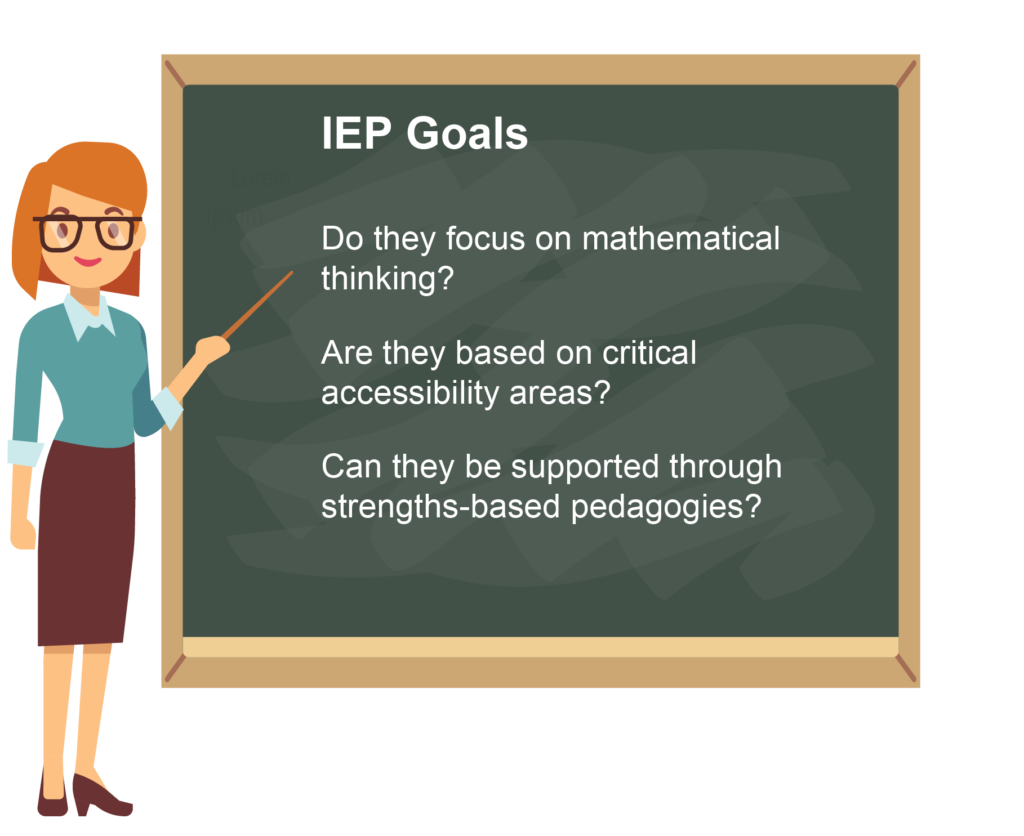
Individualized Educational Plan (IEP) goals serve to focus and measure our work with students who have identified learning disabilities. They are the result of collaboration between educators, families, and sometimes even the student. The goals communicate beliefs and expectations for the progress students will make in a given year to all stakeholders. While we believe that each and every student is capable of developing mathematical thinking and reasoning, most definitely including students on IEPs, the IEP goals – critical levers – don’t always reflect that belief.
According to the Individuals with Disabilities Education Act (IDEA), IEPs must include, among other things, A statement of measurable annual goals, including academic and functional goals designed to meet the child’s needs that result from the child’s disability to enable the child to be involved in and make progress in the general education curriculum. The Common Core Standards for Mathematical Practice are an important part of the general education mathematics curriculum, and are rarely represented in IEP goals.
The most powerful way we can communicate our beliefs is to integrate them into the IEP goals we write for students. We propose integrating IEP goals that encompass developing mathematical practices for each and every student. We know that doing so is absolutely possible if we carefully consider and articulate students’ learning strengths and challenges to inform personalized goals, then support students toward those goals with strengths-based pedagogical strategies. Yes, this shift in crafting and supporting such goals will take time and concerted effort, but let’s take a look at a four-part process for developing them and examples of draft goals.
- Analyze students’ areas of accessibility
- Consider pedagogical strategies
- Hone in on an aspect of mathematical thinking for the IEP goal
- Draft a mathematical thinking IEP goal!
We advocate for first analyzing students’ strengths and challenges in areas of access for mathematical thinking and reasoning, namely Visual Processing, Conceptual Processing, Language, Memory, Organization, and Attention. These areas are a subset of accessibility areas articulated in the Education Development Center’s Addressing Accessibility Project.
After steeping yourself in how students learn best, consider essential teaching strategies that will support students to engage in and develop mathematical thinking and reasoning. We draw upon the essential strategies that are integrated into our reasoning routines – Annotation, Sentence Frames and Starters, Ask Yourself Questions, Turn and Talks, and the 4 Rs (repeat, rephrase, reword, and record). You can read more about them in Routines for Reasoning.
Now, turn your attention to the mathematical thinking that would most benefit your student. We draw upon three avenues of thinking championed in the CCSS Standards for Mathematical Practice – quantitative reasoning, structural thinking, and repeated reasoning. After unpacking each of these avenues of thinking, it’s time to articulate aspects of them to serve as the basis for an IEP goal. As part of our work to unpack the avenues of thinking in Routines for Reasoning (pages 164-165), we described ‘Sample Thinking Goals’ that provide good fodder for IEP goals.
Quantitative Reasoning
Structural Thinking
Repeated Reasoning:
Finally, it’s time to weave students’ learning strengths, the standards for mathematical practice, and essential strategies together into an IEP goal.
Here are some sample goals, in rough draft form, for each of the 3 avenues of thinking.
Quantitative Reasoning:
Given a story problem, this student will identify the quantities relevant in the problem and describe their relationship to one another using sentence frames in 4 out of 5 opportunities. (K S)
K described how her student currently identifies relevant numbers in a word problem, and the student’s next step is to identify whether the numbers represent quantities or relationships, and to identify those quantities and relationships. She plans to support her student in this process through annotation – playing to her student’s strength in visual processing. She will also support her student’s mathematical attention by posing Ask Yourself Questions that orient her student’s thinking to the quantities and relationships. These may include, ‘What can I count or measure in this situation?’ or ‘Is the number a value for a quantity or is it describing a relationship?’. In addition, K plans to measure her student’s quantitative reasoning with the integration of sentence frames to support expressive communication for her student.
Structural Thinking:
The student will be able to learn to change the form of a numeric expression in order to arrive at a solution more efficiently. (Rachael Silver)
Rachael plans to support her student in this goal through Ask Yourself Questions (such as “how can I change the form to make this easier?”) to orient his thinking and to provide him with language to support his thinking. Over time, he’ll take ownership of the Ask Yourself Questions and will be able to self-start his thinking with them. She plans to integrate the 4 Rs to provide additional language support and processing time.
Repeated Reasoning:
When approaching a difficult or unfamiliar problem, my student will look for regularity in the way he is calculating or counting and use the repetition to generalize a larger math statement. The teacher will see/hear evidence of at least two instances of repetition. (Emily, 8th grade math teacher)
Emily described how this goal would support her student to get started in a problem-solving situation, would help the student see the value of organization in their thinking, She plans to support the student by posing Ask Yourself Questions (e.g., ‘Do I keep doing the same set of calculations each time? or Am I counting in the same way each time?’) and slowly transferring ownership of the Ask Yourself Questions to the student to promote independence.
Learn more about supporting students with learning disabilities to think and reason mathematically by joining us in Essential Strategies for Teaching Students with Learning Disabilities to Think Mathematically, a 3-day intensive remote course. Leave ready to draft goals like the ones above so that you can support your students with learning disabilities to think and reason mathematically!
